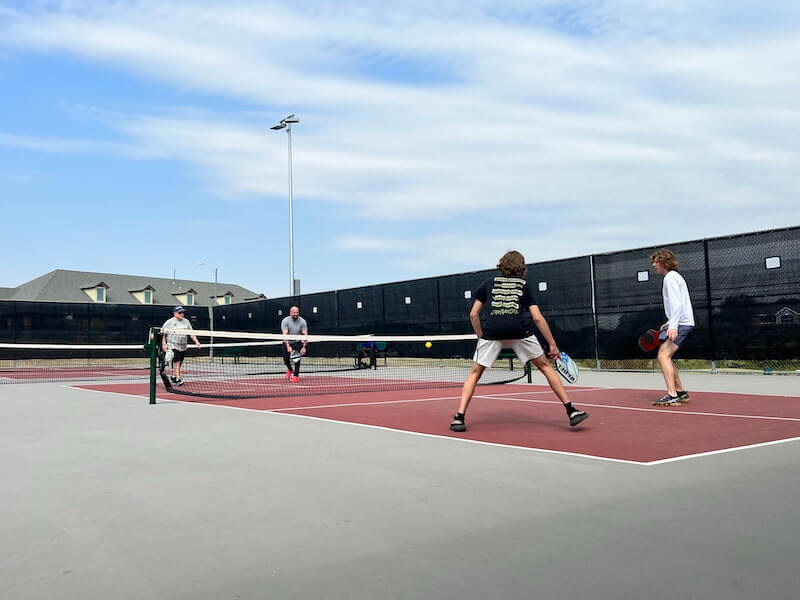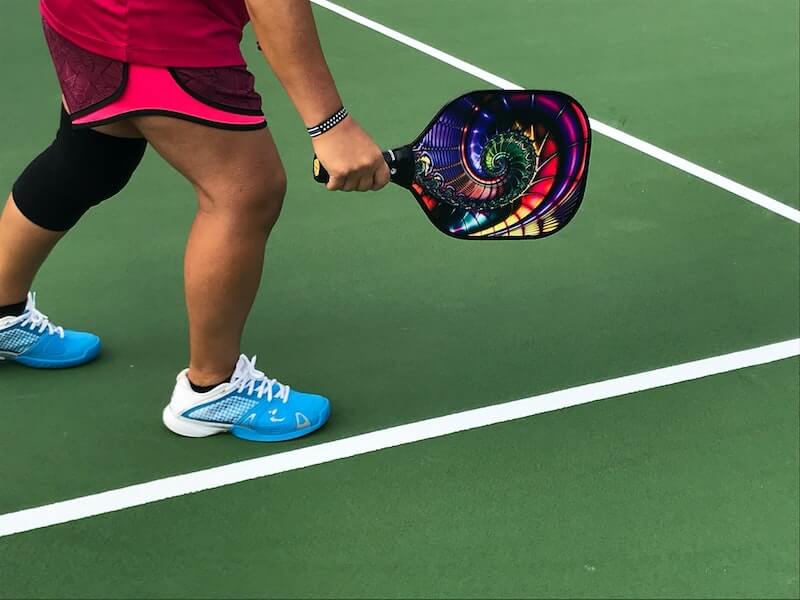Whether you’re an experienced pickleball player or a novice just picking up the sport, it’s important to understand the basic parts of a pickleball court before you start playing.
Knowing the rules of the game will help you stay focused on your strategy, stay safe, and most importantly, have fun! A pickleball court has six distinct parts that all work together to create the perfect environment.
Let’s break down each part and talk about how they contribute to the game.
What Is the Difference Between a Pickleball Court and a Badminton Court?
Pickleball and badminton are two popular racquet sports. Though they each have their own playing rules and vary greatly in the equipment they use, the court dimensions are actually the same. Badminton and pickleball courts both measure 20 feet by 44 feet.
However, there are some key differences between the two courts:
- Net height: A pickleball is 36 inches high at the sides and 34 inches high at the center. The net height in badminton is 5 feet 1 inch at the center.
- Non-volley zone (NVZ): The NVZ in pickleball is an area 7 feet from the net where players can’t volley. Badminton courts do not have this rule and zone.
- Serve line: The serve line in pickleball is 20 feet from the net. The serve line in badminton is 6.5 feet from the net.
Below is a table to sum up the key differences mentioned between a pickleball and badminton court. This doesn’t include all the zones and lines yet, so stay tuned for those!
| Feature | Pickleball | Badminton |
| Dimensions | 20 feet by 44 feet |
20 feet by 44 feet
|
| Net height | 36 inches at the sides, 34 inches at the center |
5 feet 1 inch at the center
|
| Non-volley zone (NVZ) | Yes | No |
| Serve line | 20 feet from the net |
6.5 feet from the net
|
One can argue that these differences make pickleball a more forgiving game than badminton. The lower net height and smaller paddles make it easier for players to hit the ball, and the NVZ prevents players from camping out at the net. This makes pickleball a good option for players of all ages and skill levels.

What Is the Difference Between Indoor Pickleball and Outdoor Pickleball?
You may not think there’s a lot of difference between an indoor and outdoor pickleball court, but there are actually quite a few differences between the two.
- For one, indoor pickleball is usually played on a badminton court, while outdoor pickleball is generally played on a tennis court.
- Indoor pickleball courts can be made of wood or synthetic materials, but outdoor pickleball courts are made of hardier materials like concrete or asphalt.
- Indoor pickleball requires players to use hard paddles and indoor balls to play. Outdoor pickleball needs softer paddles and high-density balls to counter the outside wind.
- Indoor pickleball courts require a lot of artificial lighting to make the entire court visible, without any shadows or glare. Outside courts only need good lighting at night.
Both indoor and outdoor pickleball follow the same pickleball rules, though. So, you won’t have to learn a different set of rules at least!
Parts of A Pickleball Court
To help you visualize the pickleball court whilst reading through the article. We created this graphic with all the labels and measurements of the court.

The Net
The net is one of the most important parts of a pickleball court! The net should be hung 36 inches high in the center and should extend 34 feet across from one side to the other. It’s essential to make sure that the net is properly hung so that it isn’t too low or too high, which can potentially interfere with gameplay.

The Court Boundaries
The court boundaries are what define the physical space where players can play their game. The boundary lines are typically marked with tape or spray painted on both sides of the net, indicating where players can stand while they’re playing. This helps ensure that everyone stays within their designated area so that everyone can enjoy a safe, fair game.
The Service Line
The service line in pickleball is located 20 feet from the net, on each side of the court. The service line in pickleball is a boundary line that players must stand behind when serving the ball. If a player steps on or over the service line while serving, the serve is considered a fault.
The service line is also used to determine if a serve is in or out. A serve is considered in if it lands in the service court diagonally opposite the server’s side of the court and within the boundaries of the court. A serve is considered out if it lands outside of the service court or touches any of the lines.
By understanding where the service line is, players can avoid making service faults and ensure that their serves are always in bounds. For you to know better about the service line we have here serving rules in pickleball.
The Baseline
The baseline is located at both ends of the court. They mark where each team should stand when receiving a serve or during regular play. The baseline should always remain parallel with either side of the net, creating two separate halves on either side of it—called left-side baselines and right-side baselines—so that players know exactly where they should stand during gameplay.
Here are some additional rules about the baseline in pickleball:
- Players must stand behind the baseline when receiving a serve.
- Players must not step on or over the baseline until the ball has been served.
- If the serve is in, the receiving player must return the ball so that it bounces once on their side of the court and then once on the server’s side of the court.
The Centerline
The centerline divides the two halves of each team’s court into two equal sections—the left and right service courts. It plays a role in determining which team is responsible for serving the ball. When a team wins a point, they switch sides of the court, depending on what their score is. A serving team with an even score has to serve on the right side, then serve again on the left after their score becomes an odd number.
Non-Volley Zone
Lastly, there is a non-volley zone (also known as “the kitchen”) located 7 feet on both sides of the net. This area prohibits any volleys from being made while the player is standing inside it or on the boundary lines. If a player does attempt to volley from within the kitchen, he will be committing a fault.
Essential Pickleball Equipment
The only two pickleball equipment you really need are the pickleball wiffle ball and your paddle. You can play without a pickleball bag, tennis shoes, hats and glasses, but you can’t play without your ball and paddle.
Not all balls and paddles are made equally, either. In fact, some may not be allowed onto official tournaments and games. To check whether you can use your balls and paddles in an official match, try searching for them here.
Here’s a quick description of what type of ball and paddle you’ll need to play pickleball.
The Ball
Pickleballs are made from plastic polymer with a hollow center filled with air. They are round with 26 holes in them, which helps them achieve their unique bounce and spin characteristics.
According to official rules, they must weigh between 0.8 ounces (22g) and 1 ounce (28g), and have a diameter between 2 inches (73mm) and 3 inches (76mm).
The Paddle
Pickleball paddles come in many shapes and sizes but all adhere to certain guidelines set forth by governing bodies.
- Generally speaking, paddles are made out of any safe material, as long as it is rigid and non-compressible.
- The surface should not have any holes, cracks, dents or delamination. It should not be reflective, since this can interfere with the opposing player’s vision.
- The total combined length and width of your paddle must not exceed 24 inches, the total length must not go beyond 17 inches, and it can weigh as light or as heavy as you want!
As far as grip size goes, this will depend entirely on personal preference. Most players use 4 1/4″ because it allows them to generate lots of speed without sacrificing control too much. Some people even go down as small as 3 5/8″! It’s best that you try out different paddle models before buying.

Playing The Game
Pickleball can be played as a single player or as a doubles team, depending on preference. However, standard scoring for both is done using a 15-point system, and the winning team must have two points more than their opponent. This means, if one team has 14 points, then their opponents has to get 16 points if they want to win the game.
Conclusion
No matter how new or experienced you are at playing pickleball, knowing all the parts of a pickleball court is essential for ensuring an enjoyable game every time. Become familiar with each element as this will help you become a more focused athlete.
Understanding why these elements exist will help you become an even better player, so get out there and show off your newfound knowledge in your next match. You got this!
































